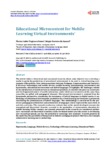Use este identificador para citar ou linkar para este item:
http://www.alice.cnptia.embrapa.br/alice/handle/doc/986981Registro completo de metadados
| Campo DC | Valor | Idioma |
|---|---|---|
| dc.contributor.author | SOUZA, M. I. F. | pt_BR |
| dc.contributor.author | AMARAL, S. F. do | pt_BR |
| dc.date.accessioned | 2014-05-26T11:11:11Z | pt_BR |
| dc.date.available | 2014-05-26T11:11:11Z | pt_BR |
| dc.date.created | 2014-05-26 | pt_BR |
| dc.date.issued | 2014 | pt_BR |
| dc.identifier.citation | Creative Education, v. 5, n. 9, p. 672-681, May, 2014. | pt_BR |
| dc.identifier.uri | http://www.alice.cnptia.embrapa.br/alice/handle/doc/986981 | pt_BR |
| dc.description | The article relates a theoretical and conceptual research, whose main objective was to develop a model to guide the production of educational microcontent to be used in virtual learning environment with mobility, from interconnections between Pedagogy, Communication and Semiotics. It discusses technologies and mobile devices, mobile learning, microlearning, microcontent and hypermedia, educational microcontent and hybrid languages. It highlights the challenges related to the introduction of mobile devices in educational practices. It considers the physical constraints and the fragmented nature of mobile interaction, under which microcontent is, at the same time, accessible and gifted with pedagogical elements. Educational microcontent is analyzed from the hypermedia perspective, considering the dominance of hybrid languages in digital media. A methodology of educational microcontent production for virtual learning environment is presented, considering the predominance of hybrid languages. This methodology is constituted by the processes: pedagogical architecture and architecture of languages, which represent the main flows of activities and tasks. The research conclusions indicate that: a) the model developed presents the conceptual and theoretical elements essential to the production of microcontent education for mobile learning; b) the concepts and grounds presented in the research are considered preliminary conceptual and theoretical elements; c) the developed model provides grants to developing new research proposals and has the potential to encourage new academic research projects; d) the model has the possibility of being used in didactic-pedagogical projects that focus, for example, collaborative learning and co-authorship. | pt_BR |
| dc.language.iso | eng | eng |
| dc.rights | openAccess | eng |
| dc.subject | Hipermidia | pt_BR |
| dc.subject | Linguagem | pt_BR |
| dc.subject | Educação à distãncia | pt_BR |
| dc.title | Educational microcontent for mobile learning virtual environments. | pt_BR |
| dc.type | Artigo de periódico | pt_BR |
| dc.date.updated | 2014-05-26T11:11:11Z | pt_BR |
| dc.subject.thesagro | Tecnologia da Informação | pt_BR |
| riaa.ainfo.id | 986981 | pt_BR |
| riaa.ainfo.lastupdate | 2014-05-26 | pt_BR |
| dc.contributor.institution | MARCIA IZABEL FUGISAWA SOUZA, CNPTIA; SÉRGIO FERREIRA DO AMARAL, Unicamp. | pt_BR |
| Aparece nas coleções: | Artigo em periódico indexado (CNPTIA)  | |
Arquivos associados a este item:
| Arquivo | Descrição | Tamanho | Formato | |
|---|---|---|---|---|
| educationalCE2014052611374831.pdf | 1,76 MB | Adobe PDF |  Visualizar/Abrir |









